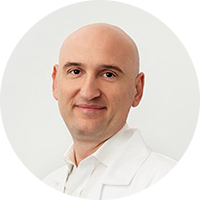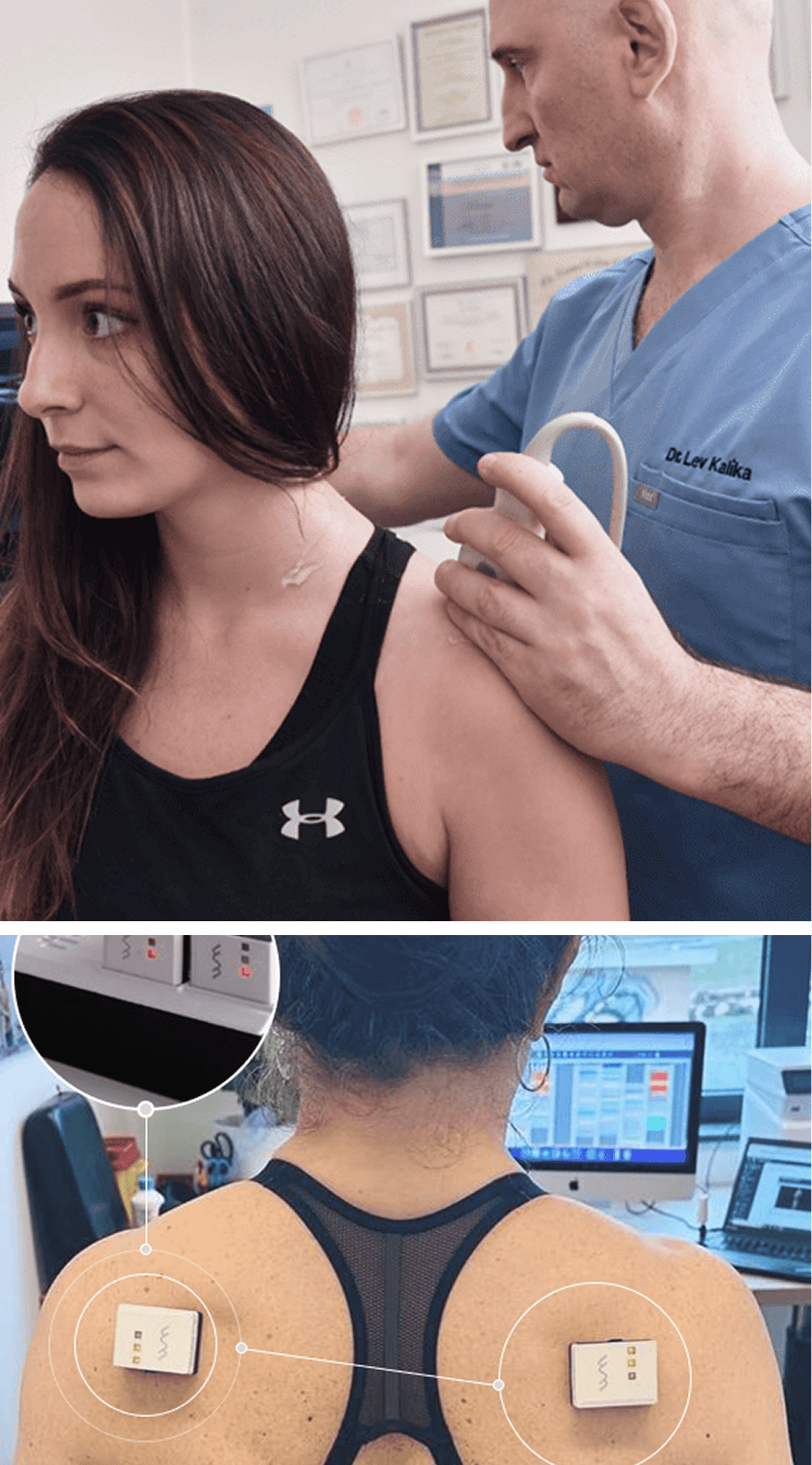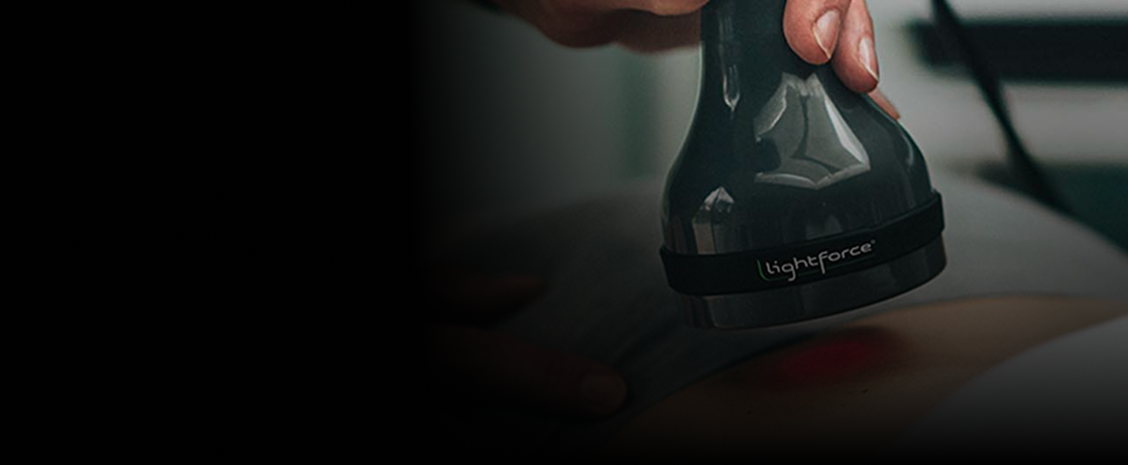
Verified by .Opencare.com
Advanced Technologies for Next-Level Shoulder Therapy
Your shoulder’s unique ball-and-socket architecture enables you to move your arm through multiple planes of motion, but the mobility it affords also makes the shoulder joint the most unstable joint in the body. Add to that the complex network of nerves, blood vessels, muscles and fascia that govern shoulder movement, and you have the potential for pain and dysfunction to arise from multiple sources.
High resolution diagnostic ultrasonography provides an invaluable tool for dynamically visualizing the shoulder’s tissues and structures in real time. Ultrasound imaging takes the guesswork out of diagnosis and treatment, ensuring that you receive the best possible shoulder rehabilitation.

Dr. Lev Kalika
Dr. Kalika and Dr. Brosgol are Revolutionizing the Way Shoulder Conditions are Diagnosed and Treated
Dr. Lev Kalika, DC, RMSK,has devoted his life’s work to finding innovative and effective ways to treat musculoskeletal pain and dysfunction. In addition to operating his Manhattan clinical practice, Dr. Kalika regularly conducts and publishes research on the use of musculoskeletal ultrasonography in rehabilitative medicine, and has presented his work at multiple international conferences..
Dr. Kalika has developed his own holistic methodology for diagnosing shoulder pain, using high resolution ultrasonography and kinematic motion analysis technology. He studied directly under Dr. Ben Kibler, world-renowned orthopedic surgeon and pioneer of scapular dyskinesis. Dr. Kalika is one of the few experts in the USA trained in scapular (shoulder blade) ultrasonography. His approach to adhesive capsulitis (frozen shoulder syndrome) often delivers groundbreaking results after just the first treatment.

Dr. Yuri Brosgol
Dr. Yuri Brosgol, MD is a neurologist with 20+ years of experience in treating pediatric and adult myofascial pain. As a pioneer in orthobiologics and fascial release techniques, Dr. Brosgol learned fascial hydro release methodology directly from Dr. Carla Stecco, the world’s leading specialist in fascial science. His expertise in orthobiologic needling procedures under ultrasound guidance means you get safe and accurate treatment that maximizes results.
Together, Dr. Kalika and Dr. Brosgol are revolutionizing the way shoulder pain and injuries are diagnosed and treated. The clinic at NYDNRehab features some of the most advanced technologies and therapies available for shoulder injury rehabilitation.
Accurate Diagnosis is Key to Successful Shoulder Treatment
Diagnosis of shoulder pathology typically relies on reported symptoms, findings from a clinical exam, and testing for strength and range of motion. While that approach can help to narrow down possible causes, it may overlook critical aspects of your injury, resulting in mistreatment, prolonged pain, and excess medical costs.
At NYCIRG, we use high-resolution diagnostic ultrasound to view your shoulder in real time, enabling us to:
- Compare the injured and uninjured shoulders
- View nerves, muscles, fascia and bones along their entire path
- Identify fascial densifications and adhesions, and myofascial trigger points
- Detect the exact site of nerve compression or entrapment
- View multiple tissues and structures in a single session
- Elicit patient feedback during the imaging session
In addition to high-resolution imaging, our ultrasound gives us capabilities for sonoelastography to gauge muscle and tendon stiffness, and superior microvascular imaging to detect early signs of healing and monitor patient progress. Your ultrasound exam takes place on your very first visit, in the comfort of our clinic. Quick and accurate diagnosis means you can begin therapy right away, with no wait time for lab results.

New Technologies Redefine Shoulder Diagnosis and Therapy
The complexity of the shoulder region makes it difficult to identify the exact source of shoulder pain and dysfunction, and in many cases, multiple factors come into play. High resolution ultrasound imaging provides an advanced and effective diagnostic tool, especially when coupled with new technologies that dramatically enhance visualization and facilitate shoulder rehabilitation.
ShowMotion
ShowMotion is an objective tool for joint movement analysis that uses motion tracking sensors, placed on the patient’s skin to collect data about movement quality. The patient performs a series of joint-specific movements, and the data is analyzed by ShowMotion’s proprietary software.
The collected information provides valuable insights about inefficient muscle recruitment patterns, compensation patterns, and improvements in response to therapy, enabling practitioners to personalize shoulder rehabilitation.
Neuralign Shoulder Pacemaker
The Neuralign Shoulder Pacemaker is a shoulder rehabilitation device with a kinematic sensor activated by movement. The patient dynamically interacts with the device to stimulate efficient muscle recruitment patterns, enhance movement quality, and restore optimal muscle balance during rehabilitation. The sensor provides objective data that practitioners can use to support decision-making and personalize shoulder rehabilitation.
The Shoulder Pacemaker can be used to target several common conditions:
- Rotator cuff disorders
- Scapular dyskinesis
- Shoulder instability
- Neck pain related to abnormal shoulder movement
- Shoulder and arm pain caused by nerve entrapment
The Shoulder Pacemaker is also a cutting-edge tool for enhancing athletic performance in shoulder-intensive sports like swimming, tennis, baseball and others.
Scapular Ultrasound Detects Mechanical Deficiencies
High-resolution ultrasound is an important tool for observing scapular movement relative to the humeral head of the shoulder joint. Combining scapular ultrasound with ShowMotion technology provides substantial information for comprehensive shoulder rehabilitation.
The scapula compensates for shoulder instability by acting as a stable base for the glenoid fossa, to optimize positioning of the humeral head. Dynamic scapular stabilization requires well-coordinated muscle activation patterns, especially of the rotator, deltoid, trapezius and rhomboid muscles. Scapular dysfunction can increase strain on the rotator cuff and labrum, contributing to pain and instability.
Dynamic scapular imaging lets us observe the complex interactions of the shoulder girdle kinetic chain, to pinpoint issues such as deficiencies in muscle activation, glenohumeral joint subluxation, and capsular laxity that contribute to shoulder instability. For JHS/EDS patients, scapular ultrasound can be a game-changer, ensuring they receive proper rehabilitation that enhances stability after a shoulder dislocation.
According to Dr. Kalika, shoulder pain is too often mismanaged, focusing on the rotator cuff while ignoring the scapula. Physical therapy is most effective when the structural integrity of the scapular muscles and nerves is restored. Unless the shoulder girdle/neck complex is addressed holistically, therapies targeting the rotator cuff deliver only mediocre results. However, few physical therapists know how to approach chronic shoulder blade pain and scapular dyskinesis.
As a life-long learner, Dr. Kalika keeps up-to-date with the latest therapeutic approaches and technologies. He frequently participates in international workshops and conferences, where he rubs elbows with some of the world’s most renowned orthopedic specialists in shoulder pain and scapular dyskinesis.

Shoulder Conditions We Treat at NYCIRG
Rotator cuff tendinopathy
Shoulder bursitis
Impingement of tendons, bursae, nerves and blood vessels
Labral cartilage ruptures

Shoulder instability
Frozen shoulder syndrome
Shoulder osteoarthritis
Postural issues that contribute to shoulder pain
Scapular pain and dyskinesis
Symptoms, Causes and Risk Factors of
Shoulder Pain
Symptoms
- Pain in the shoulder, back and/or neck
- Bruising
- Clicking or popping noises or sensations
- Grinding sensation
- Muscle stiffness and weakness
- Restricted overhead movement
Causes
- Repetitive overhead shoulder motion
- Arthritis and gout
- Bone fractures
- Bursitis
- Frozen shoulder syndrome
- Rotator cuff ruptures
- Shoulder joint dislocation
- Poor posture
Risk Factors
- Advanced age
- Repetitive occupational tasks
- Overhead sports
- Poor posture
- Previous shoulder injuries
- Metabolic disorders
- Smoking
- Chronic stress and systemic inflammation
Orthobiologic Procedures Dramatically
Accelerate Tissue Healing
Orthobiologic injection therapies use natural/neutral solutions, injected with precision under ultrasound guidance. The injected solutions stimulate cellular repair by either nourishing or irritating the targeted cells, triggering a regenerative response. However, orthobiologics are not a stand-alone solution – they only address tissue biology, but cannot restore functional mechanics.
At NYCIRG, we incorporate orthobiologics as part of our multimodal treatment strategy. Our holistic approach optimizes results and speeds recovery, so you can quickly return to play.
Multiple factors make orthobiologic procedures at NYDNRehab superior to other clinics:
- All procedures are guided by high-resolution ultrasound imaging, ensuring that the orthobiologic solutions precisely penetrate targeted tissues.
- We use the highest-resolution ultrasonography available, with capabilities for sonoelastography and superb microvascular imaging.
- Our platelet-rich plasma (PRP) solutions are formulated with the highest and most efficacious concentration of platelets.
- We offer multiple types of PRP, for tissue-specific results.
- Our ultrasound-guided Prolotherapy injections enhance tissue regeneration.
- Fascial and nerve hydrorelease procedures free up entrapped nerves and blood vessels and restore fascial gliding.
Orthobiologic procedures available at NYCIRG:

Regenerative Technologies are Game-
Changers for Successful Shoulder Therapy
Regenerative therapies tap into the body’s natural healing mechanisms by stimulating the migration of stem cells, growth factors and immune cells to the treatment site, to promote the neogenesis of cells and blood vessels and accelerate the healing process. When carefully selected and combined with orthobiologics, regenerative therapies enhance their effects, and vice-versa.
Orthobiologics + Regenerative Technologies =
Optimal Tissue Healing
By carefully selecting and combining the most appropriate therapies, we are able to harness the synergistic effects of both regenerative technologies and orthobiologics, for superior and enduring results.

- Stimulates resident tenocytes/chondrocytes/MSCs; complements PRP/BMAC’s cytokine effect.
- Promotes microvascular regeneration, opening biologic access to hypoxic tendons and their enthesis (point of attachment to bone).
- Upregulates angiogenic growth factors.
- Induces nitric oxide and substance P modulation, to provide pain relief without blocking inflammation.
- Supports bone–tendon junction healing.
- Creates microtrauma and mechanotransduction, releasing growth factors that synergize with injected biologics.
- Induces neovascularization, improving nutrient and oxygen delivery to injected tissues.
- Enhances the homing and activation of stem cells through SDF-1 and VEGF pathways.
- Improves extracellular matrix remodeling, preparing a scaffold for PRP/stem cell integration.

- Synchronizes with the body’s own magnetic fields.
- Helps to extend PRP’s anti-inflammatory effects, prolonging matrix remodeling and angiogenesis.
- Promotes remodeling of the extracellular matrix and collagen fiber reorganization.
- Reduces fibrotic adhesions and minimizes scarring, especially in tendons, fascia and joint capsules.
- Acts as a biological booster to prolong PRP regenerative effects.
- Promotes long-term structural repair of tendons, ligaments and joints.
- Enhances cell membrane permeability, improving migration, adhesion, and integration of injected PRP/stem cells.
- Stimulates ion channel activity (Ca²⁺, Na⁺, K⁺), supporting regenerative signaling.
- Promotes angiogenesis and microcirculation, improving survival of transplanted cells.
- Reduces oxidative stress and inflammation, creating a favorable niche for stem cell activity.

- Restores the ionic charge of damaged cells, for faster injury healing.
- Boosts blood flow and enhances local circulation to improve delivery of nutrients and immune cells to the treatment site.
- May improve PRP dispersal
- Promotes lymphatic drainage of inflammatory byproducts.
- Promotes fibroblast activity and collagen remodeling at the PRP treatment site.
- Assists in eliminating fascial densifications and adhesions, and restoring tissue gliding.
- Increases deep tissue perfusion and oxygenation, boosting injected cell survival.
- Enhances metabolic activity and waste clearance, optimizing the healing environment.
- Enhances cell membrane permeability, improving migration, adhesion, and integration of injected PRP/stem cells.
- Stimulates ion channel activity (Ca²⁺, Na⁺, K⁺), supporting regenerative signaling.
- Promotes angiogenesis and microcirculation, improving survival of transplanted cells.
- Reduces oxidative stress and inflammation, creating a favorable niche for stem cell activity.
- Provides analgesia and reduction of muscle spasm, facilitating early functional rehab after injections.
- Improves viscoelasticity of tissues, allowing better integration of regenerative cells.

- Works via photobiomodulation (PBM), delivering light energy to specific tissues that is absorbed by mitochondria (the energy-producing organelles within cells).
- Triggers a cascade of biochemical events, including increased cellular metabolism, reduced inflammation, improved blood flow, and enhanced tissue regeneration.
- Stimulates mitochondrial ATP production.
- Upregulates growth factors (TGF-β, VEGF), enhancing the effects of PRP.
- Enhances local blood perfusion and oxygenation to improve platelet distribution.
- Reduces post-injection inflammation without suppressing the regenerative cascade.
- Accelerates activation of fibroblast, chondrocyte, and tenocyte cells.
- Promotes collagen repair.
- Stimulates mitochondrial ATP production, energizing injected cells.
- Enhances cell proliferation and differentiation of PRP and stem cell populations.
- Reduces inflammation and pain, protecting the fragile early healing phase post-injection.
- Promotes collagen synthesis and angiogenesis, complementing regenerative injection effects.
When delivered at the most effective levels under ultrasound guidance, ESWT + EMTT prime the microenvironment via mechanical and electromagnetic stimulation. TECAR + Laser therapy optimizes tissue metabolism, circulation, and cellular energy. Together, they extend and amplify the biological effects of PRP and stem cells, accelerating tissue integration, repair, and functional recovery.
In addition, when used post-procedure, regenerative therapies dramatically reduce pain and discomfort, reinforce soft tissue healing, and promote collagen fiber realignment.
Hands-On Therapies Help Restore
Unrestricted Shoulder Range of Motion

Stecco Fascial Manipulation
Dr. Kalika is at the forefront of pioneering work on fascia, the network of connective tissue that encases and connects muscles and organs throughout the body. Fascia plays an important role in stabilizing the shoulder joint and enabling nerves and blood vessels to glide smoothly among other structures.
The Stecco approach is a special technique used to target myofascial trigger points and restore the gliding properties of densified fascia, Stecco therapy is an integral part of our multifaceted approach to myofascial pain and dysfunction. Dr. Kalka is certified in the Stecco method of fascia manipulation, and uses it to target fascia densifications and nerve entrapments that impede shoulder movement.

Dynamic Neuromuscular Stabilization (DNS)
DNS is a holistic treatment approach that taps into your primal developmental software to help restore efficient movement patterns and optimize pain-free shoulder function. Your shoulder joint depends on local stabilizing muscles, tendons and ligaments, as well as coordination of both local and distal muscles, to maintain a neutral position of the humeral head in its socket. As a highly mobile joint, the shoulder relies heavily on both local and global stabilizers to assist in force transfer while protecting shoulder architecture.
Dynamic neuromuscular stabilization helps to optimize shoulder function by correcting joint misalignment and restoring coordinated muscle recruitment patterns that have been lost over time. Dr. Kalika learned DNS directly from its creator, Dr. Pavel Kolar, and was one of the first practitioners to introduce DNS to the US rehabilitative community.

Our Shoulder Physical Therapy is
Customized for Every Patient
At NYCIRG, we treat the whole patient, not just your symptoms. We never use one-size-fits-all rehab protocols or standardized recovery timelines. We believe that every injury is unique, and treatment should be based on the patient’s unique profile.
Once we have successfully pre-treated your damaged tissues, we can begin one-on-one physical therapy to restore strength and stability, optimize mobility, and re-establish optimal neuromuscular pathways and muscle coordination patterns.
Your treatment protocol may include a combination of the following approaches:
- Stecco fascial manipulation, to eliminate densifications and adhesions and restore fascia’s gliding properties
- Postural restoration therapy to optimize total-body joint alignment
- Dynamic neuromuscular stabilization (DNS) to restore developmental motor strategies
- Integrated systems model (ISM) to optimize function and performance
- Anatomy in motion (AIM) to enhance movement quality
- Neurodynamics, to restore communication pathways between the brain and body
- Conventional eccentric loading and strengthening exercises
For athletes, your back-to-sports protocol may include sport-specific training to optimize motor skills and restore peak athletic performance. We carefully monitor patient progress with ultrasound imaging to confirm complete recovery.

Get the Most Advanced Therapy for Shoulder Pain in NYC
The conventional reductionist approach to shoulder pain is to treat structures in isolation, often overlooking key factors that contribute to shoulder pathologies. Patients often suffer through multiple rounds of steroid injections, narcotic pain medications and even surgeries before they finally come to NYCIRG for help.
Our advanced diagnostic tools and integrative treatment approaches help us to accurately identify and treat the root cause of shoulder pain and eradicate it for good. Our personalized one-on-one treatment protocols are custom-designed for the individual patient.
You don’t have to live with shoulder pain and dysfunction. Contact NYCIRG today, and get advanced shoulder therapy that really works!















Hours of Operation



















